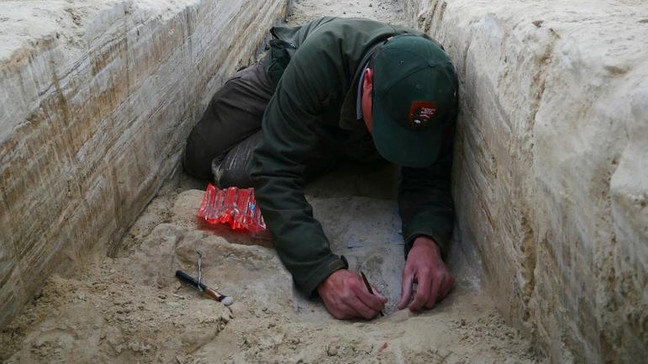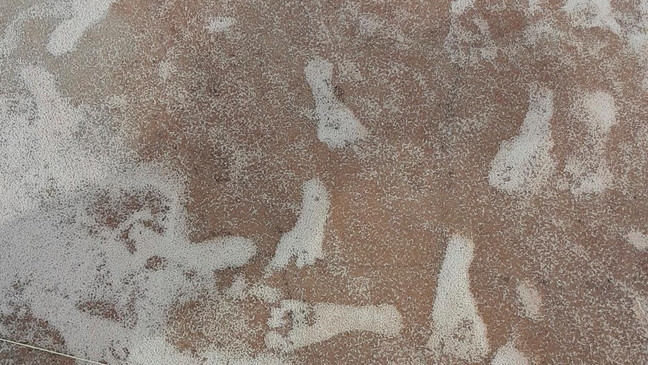Human footprints found in New Mexico are between 21,000 and 23,000 years old, scientists confirm
WASHINGTON (TND) — Fossilized human footprints found in New Mexico in White Sands National Park date back to between 21,000 and 23,000 years ago, according to research published in the journal Science.
The research confirms what is likely the oldest direct evidence of human presence in the Americas and upends what many archaeologists thought they knew about when our ancestors arrived in the New World.
The original study about the footprints was reported in Science in 2021 but some questioned the accuracy of the findings.
{sd-embed class="sd-embedded-media" data-embed-file="%3Cblockquote%20class=%22instagram-media%22%20data-instgrm-captioned%20data-instgrm-permalink=%22https://www.instagram.com/p/CyLqyc9h-Ut/?utm_source=ig_embed&utm_campaign=loading%22%20data-instgrm-version=%2214%22%20style=%22%20background:#FFF;%20border:0;%20border-radius:3px;%20box-shadow:0%200%201px%200%20rgba(0,0,0,0.5),0%201px%2010px%200%20rgba(0,0,0,0.15);%20margin:%201px;%20max-width:540px;%20min-width:326px;%20padding:0;%20width:99.375%25;%20width:-webkit-calc(100%25%20-%202px);%20width:calc(100%25%20-%202px);%22%3E%3Cdiv%20style=%22padding:16px;%22%3E%20%3Ca%20href=%22https://www.instagram.com/p/CyLqyc9h-Ut/?utm_source=ig_embed&utm_campaign=loading%22%20style=%22%20background:#FFFFFF;%20line-height:0;%20padding:0%200;%20text-align:center;%20text-decoration:none;%20width:100%25;%22%20target=%22_blank%22%3E%20%3Cdiv%20style=%22%20display:%20flex;%20flex-direction:%20row;%20align-items:%20center;%22%3E%20%3Cdiv%20style=%22background-color:%20#F4F4F4;%20border-radius:%2050%25;%20flex-grow:%200;%20height:%2040px;%20margin-right:%2014px;%20width:%2040px;%22%3E%3C/div%3E%20%3Cdiv%20style=%22display:%20flex;%20flex-direction:%20column;%20flex-grow:%201;%20justify-content:%20center;%22%3E%20%3Cdiv%20style=%22%20background-color:%20#F4F4F4;%20border-radius:%204px;%20flex-grow:%200;%20height:%2014px;%20margin-bottom:%206px;%20width:%20100px;%22%3E%3C/div%3E%20%3Cdiv%20style=%22%20background-color:%20#F4F4F4;%20border-radius:%204px;%20flex-grow:%200;%20height:%2014px;%20width:%2060px;%22%3E%3C/div%3E%3C/div%3E%3C/div%3E%3Cdiv%20style=%22padding:%2019%25%200;%22%3E%3C/div%3E%20%3Cdiv%20style=%22display:block;%20height:50px;%20margin:0%20auto%2012px;%20width:50px;%22%3E%3Csvg%20width=%2250px%22%20height=%2250px%22%20viewBox=%220%200%2060%2060%22%20version=%221.1%22%20xmlns=%22https://www.w3.org/2000/svg%22%20xmlns:xlink=%22https://www.w3.org/1999/xlink%22%3E%3Cg%20stroke=%22none%22%20stroke-width=%221%22%20fill=%22none%22%20fill-rule=%22evenodd%22%3E%3Cg%20transform=%22translate(-511.000000,%20-20.000000)%22%20fill=%22#000000%22%3E%3Cg%3E%3Cpath%20d=%22M556.869,30.41%20C554.814,30.41%20553.148,32.076%20553.148,34.131%20C553.148,36.186%20554.814,37.852%20556.869,37.852%20C558.924,37.852%20560.59,36.186%20560.59,34.131%20C560.59,32.076%20558.924,30.41%20556.869,30.41%20M541,60.657%20C535.114,60.657%20530.342,55.887%20530.342,50%20C530.342,44.114%20535.114,39.342%20541,39.342%20C546.887,39.342%20551.658,44.114%20551.658,50%20C551.658,55.887%20546.887,60.657%20541,60.657%20M541,33.886%20C532.1,33.886%20524.886,41.1%20524.886,50%20C524.886,58.899%20532.1,66.113%20541,66.113%20C549.9,66.113%20557.115,58.899%20557.115,50%20C557.115,41.1%20549.9,33.886%20541,33.886%20M565.378,62.101%20C565.244,65.022%20564.756,66.606%20564.346,67.663%20C563.803,69.06%20563.154,70.057%20562.106,71.106%20C561.058,72.155%20560.06,72.803%20558.662,73.347%20C557.607,73.757%20556.021,74.244%20553.102,74.378%20C549.944,74.521%20548.997,74.552%20541,74.552%20C533.003,74.552%20532.056,74.521%20528.898,74.378%20C525.979,74.244%20524.393,73.757%20523.338,73.347%20C521.94,72.803%20520.942,72.155%20519.894,71.106%20C518.846,70.057%20518.197,69.06%20517.654,67.663%20C517.244,66.606%20516.755,65.022%20516.623,62.101%20C516.479,58.943%20516.448,57.996%20516.448,50%20C516.448,42.003%20516.479,41.056%20516.623,37.899%20C516.755,34.978%20517.244,33.391%20517.654,32.338%20C518.197,30.938%20518.846,29.942%20519.894,28.894%20C520.942,27.846%20521.94,27.196%20523.338,26.654%20C524.393,26.244%20525.979,25.756%20528.898,25.623%20C532.057,25.479%20533.004,25.448%20541,25.448%20C548.997,25.448%20549.943,25.479%20553.102,25.623%20C556.021,25.756%20557.607,26.244%20558.662,26.654%20C560.06,27.196%20561.058,27.846%20562.106,28.894%20C563.154,29.942%20563.803,30.938%20564.346,32.338%20C564.756,33.391%20565.244,34.978%20565.378,37.899%20C565.522,41.056%20565.552,42.003%20565.552,50%20C565.552,57.996%20565.522,58.943%20565.378,62.101%20M570.82,37.631%20C570.674,34.438%20570.167,32.258%20569.425,30.349%20C568.659,28.377%20567.633,26.702%20565.965,25.035%20C564.297,23.368%20562.623,22.342%20560.652,21.575%20C558.743,20.834%20556.562,20.326%20553.369,20.18%20C550.169,20.033%20549.148,20%20541,20%20C532.853,20%20531.831,20.033%20528.631,20.18%20C525.438,20.326%20523.257,20.834%20521.349,21.575%20C519.376,22.342%20517.703,23.368%20516.035,25.035%20C514.368,26.702%20513.342,28.377%20512.574,30.349%20C511.834,32.258%20511.326,34.438%20511.181,37.631%20C511.035,40.831%20511,41.851%20511,50%20C511,58.147%20511.035,59.17%20511.181,62.369%20C511.326,65.562%20511.834,67.743%20512.574,69.651%20C513.342,71.625%20514.368,73.296%20516.035,74.965%20C517.703,76.634%20519.376,77.658%20521.349,78.425%20C523.257,79.167%20525.438,79.673%20528.631,79.82%20C531.831,79.965%20532.853,80.001%20541,80.001%20C549.148,80.001%20550.169,79.965%20553.369,79.82%20C556.562,79.673%20558.743,79.167%20560.652,78.425%20C562.623,77.658%20564.297,76.634%20565.965,74.965%20C567.633,73.296%20568.659,71.625%20569.425,69.651%20C570.167,67.743%20570.674,65.562%20570.82,62.369%20C570.966,59.17%20571,58.147%20571,50%20C571,41.851%20570.966,40.831%20570.82,37.631%22%3E%3C/path%3E%3C/g%3E%3C/g%3E%3C/g%3E%3C/svg%3E%3C/div%3E%3Cdiv%20style=%22padding-top:%208px;%22%3E%20%3Cdiv%20style=%22%20color:#3897f0;%20font-family:Arial,sans-serif;%20font-size:14px;%20font-style:normal;%20font-weight:550;%20line-height:18px;%22%3EView%20this%20post%20on%20Instagram%3C/div%3E%3C/div%3E%3Cdiv%20style=%22padding:%2012.5%25%200;%22%3E%3C/div%3E%20%3Cdiv%20style=%22display:%20flex;%20flex-direction:%20row;%20margin-bottom:%2014px;%20align-items:%20center;%22%3E%3Cdiv%3E%20%3Cdiv%20style=%22background-color:%20#F4F4F4;%20border-radius:%2050%25;%20height:%2012.5px;%20width:%2012.5px;%20transform:%20translateX(0px)%20translateY(7px);%22%3E%3C/div%3E%20%3Cdiv%20style=%22background-color:%20#F4F4F4;%20height:%2012.5px;%20transform:%20rotate(-45deg)%20translateX(3px)%20translateY(1px);%20width:%2012.5px;%20flex-grow:%200;%20margin-right:%2014px;%20margin-left:%202px;%22%3E%3C/div%3E%20%3Cdiv%20style=%22background-color:%20#F4F4F4;%20border-radius:%2050%25;%20height:%2012.5px;%20width:%2012.5px;%20transform:%20translateX(9px)%20translateY(-18px);%22%3E%3C/div%3E%3C/div%3E%3Cdiv%20style=%22margin-left:%208px;%22%3E%20%3Cdiv%20style=%22%20background-color:%20#F4F4F4;%20border-radius:%2050%25;%20flex-grow:%200;%20height:%2020px;%20width:%2020px;%22%3E%3C/div%3E%20%3Cdiv%20style=%22%20width:%200;%20height:%200;%20border-top:%202px%20solid%20transparent;%20border-left:%206px%20solid%20#f4f4f4;%20border-bottom:%202px%20solid%20transparent;%20transform:%20translateX(16px)%20translateY(-4px)%20rotate(30deg)%22%3E%3C/div%3E%3C/div%3E%3Cdiv%20style=%22margin-left:%20auto;%22%3E%20%3Cdiv%20style=%22%20width:%200px;%20border-top:%208px%20solid%20#F4F4F4;%20border-right:%208px%20solid%20transparent;%20transform:%20translateY(16px);%22%3E%3C/div%3E%20%3Cdiv%20style=%22%20background-color:%20#F4F4F4;%20flex-grow:%200;%20height:%2012px;%20width:%2016px;%20transform:%20translateY(-4px);%22%3E%3C/div%3E%20%3Cdiv%20style=%22%20width:%200;%20height:%200;%20border-top:%208px%20solid%20#F4F4F4;%20border-left:%208px%20solid%20transparent;%20transform:%20translateY(-4px)%20translateX(8px);%22%3E%3C/div%3E%3C/div%3E%3C/div%3E%20%3Cdiv%20style=%22display:%20flex;%20flex-direction:%20column;%20flex-grow:%201;%20justify-content:%20center;%20margin-bottom:%2024px;%22%3E%20%3Cdiv%20style=%22%20background-color:%20#F4F4F4;%20border-radius:%204px;%20flex-grow:%200;%20height:%2014px;%20margin-bottom:%206px;%20width:%20224px;%22%3E%3C/div%3E%20%3Cdiv%20style=%22%20background-color:%20#F4F4F4;%20border-radius:%204px;%20flex-grow:%200;%20height:%2014px;%20width:%20144px;%22%3E%3C/div%3E%3C/div%3E%3C/a%3E%3Cp%20style=%22%20color:#c9c8cd;%20font-family:Arial,sans-serif;%20font-size:14px;%20line-height:17px;%20margin-bottom:0;%20margin-top:8px;%20overflow:hidden;%20padding:8px%200%207px;%20text-align:center;%20text-overflow:ellipsis;%20white-space:nowrap;%22%3E%3Ca%20href=%22https://www.instagram.com/p/CyLqyc9h-Ut/?utm_source=ig_embed&utm_campaign=loading%22%20style=%22%20color:#c9c8cd;%20font-family:Arial,sans-serif;%20font-size:14px;%20font-style:normal;%20font-weight:normal;%20line-height:17px;%20text-decoration:none;%22%20target=%22_blank%22%3EA%20post%20shared%20by%20White%20Sands%20National%20Park%20(@whitesandsnps)%3C/a%3E%3C/p%3E%3C/div%3E%3C/blockquote%3E%20%3Cscript%20async%20src=%22//www.instagram.com/embed.js%22%3E%3C/script%3E" data-embed-type="instagram" contenteditable="false"}{/sd-embed}
Questions focused on whether seeds of aquatic plants, Ruppia cirrhosa, used for the original dating may have absorbed ancient carbon from the lake — which could, in theory, throw off radiocarbon dating by thousands of years.
A new study used two entirely different materials found at the site -- ancient conifer pollen and quartz grains.
The study isolated about 75,000 grains of pure pollen from the same sedimentary layer and found the age was identical to the Ruppia cirrhosa seeds.
"Dating pollen is arduous and nail-biting," said Kathleen Springer, a research geologist at the United States Geological Survey and a co-author of the new paper. Scientists believe radiocarbon dating of terrestrial plants is more accurate than dating aquatic plants, but there needs to be a large enough sample size to analyze, she said.
To further check the dating, scientists also studied accumulated damage in the crystal lattices of ancient quartz grains to produce an age estimate.
{sd-embed class="sd-embedded-media" data-alt="AP23278616679834.jpg" data-caption="FILE%20-%20This%20Oct.%202023%20photo%20made%20available%20by%20the%20National%20Park%20Service%20shows%20%20White%20Sands%20National%20Park%20Resource%20Program%20Manager,%20David%20Bustos%20at%20the%20White%20Sands%20National%20Park%20in%20New%20Mexico.%7B%7D%20(NPS%20via%20AP)" data-duration="" data-externalid="8faac66b-3dcb-4783-9d36-6eec55444516" data-mediatype="image" data-renditions="%7B%22large16x9%22:%7B%22blurSigma%22:-1,%22height%22:432,%22label%22:%22large16x9%22,%22scaleWidth%22:986,%22url%22:%22/resources/media/42d8efa6-df48-46a9-83a2-26e26d471a1b-large16x9_AP23278616679834.jpg%22,%22width%22:769,%22x%22:0,%22y%22:561,%22uuid%22:null,%22id%22:%22adb18424-0e23-4101-8a23-3579aacbc9ed%22,%22preciseWidth%22:null,%22preciseHeight%22:null,%22name%22:%22large16x9Url%22,%22rendition%22:%22large16x9%22,%22labelOrConvertedName%22:%22large16x9%22%7D,%22jumbo16x9%22:%7B%22blurSigma%22:-1,%22height%22:432,%22label%22:%22jumbo16x9%22,%22scaleWidth%22:1320,%22url%22:%22/resources/media/42d8efa6-df48-46a9-83a2-26e26d471a1b-jumbo16x9_AP23278616679834.jpg%22,%22width%22:769,%22x%22:0,%22y%22:561,%22uuid%22:null,%22id%22:%222fc21f05-da7e-4c02-bce7-a5fb9a719543%22,%22preciseWidth%22:null,%22preciseHeight%22:null,%22name%22:%22jumbo16x9Url%22,%22rendition%22:%22jumbo16x9%22,%22labelOrConvertedName%22:%22jumbo16x9%22%7D,%22small16x9%22:%7B%22blurSigma%22:-1,%22height%22:432,%22label%22:%22small16x9%22,%22scaleWidth%22:160,%22url%22:%22/resources/media/42d8efa6-df48-46a9-83a2-26e26d471a1b-small16x9_AP23278616679834.jpg%22,%22width%22:769,%22x%22:0,%22y%22:561,%22uuid%22:null,%22id%22:%22a913a405-da62-4807-ab1d-3580f1555480%22,%22preciseWidth%22:null,%22preciseHeight%22:null,%22name%22:%22small16x9Url%22,%22rendition%22:%22small16x9%22,%22labelOrConvertedName%22:%22small16x9%22%7D,%22full16x9%22:%7B%22blurSigma%22:-1,%22height%22:432,%22label%22:%22full16x9%22,%22scaleWidth%22:769,%22url%22:%22/resources/media/42d8efa6-df48-46a9-83a2-26e26d471a1b-full16x9_AP23278616679834.jpg%22,%22width%22:769,%22x%22:0,%22y%22:561,%22uuid%22:null,%22id%22:%228f54d1c1-88a8-4d64-8de5-f82bc6d58877%22,%22preciseWidth%22:null,%22preciseHeight%22:null,%22name%22:%22full16x9Url%22,%22rendition%22:%22full16x9%22,%22labelOrConvertedName%22:%22full16x9%22%7D,%22medium16x9%22:%7B%22blurSigma%22:-1,%22height%22:432,%22label%22:%22medium16x9%22,%22scaleWidth%22:648,%22url%22:%22/resources/media/42d8efa6-df48-46a9-83a2-26e26d471a1b-medium16x9_AP23278616679834.jpg%22,%22width%22:769,%22x%22:0,%22y%22:561,%22uuid%22:null,%22id%22:%22bc52d7cf-5046-4e58-849a-4563482da2a3%22,%22preciseWidth%22:null,%22preciseHeight%22:null,%22name%22:%22medium16x9Url%22,%22rendition%22:%22medium16x9%22,%22labelOrConvertedName%22:%22medium16x9%22%7D%7D" data-thumburl="/resources/media/42d8efa6-df48-46a9-83a2-26e26d471a1b-medium16x9_AP23278616679834.jpg" data-title="AP23278616679834.jpg" data-url="" data-defaultthumb="true" data-embed-file="%0A%20%20%20%20%3Cdiv%20class=%22sda-ImageEmbed%22%3E%0A%20%20%20%20%20%20%20%20%3Cimg%20src=%22/resources/media/42d8efa6-df48-46a9-83a2-26e26d471a1b-medium16x9_AP23278616679834.jpg%22%20alt=%22%22%20/%3E%0A%20%20%20%20%20%20%20%20%3Cdiv%20class=%22sda-ImageEmbed-caption%22%3EFILE%20-%20This%20Oct.%202023%20photo%20made%20available%20by%20the%20National%20Park%20Service%20shows%20%20White%20Sands%20National%20Park%20Resource%20Program%20Manager,%20David%20Bustos%20at%20the%20White%20Sands%20National%20Park%20in%20New%20Mexico.%20(NPS%20via%20AP)%3C/div%3E%0A%20%20%20%20%3C/div%3E" data-embed-type="image" contenteditable="false"}{/sd-embed}
The reported age of the footprints challenges the once-conventional wisdom that humans didn't reach the Americas until a few thousand years before rising sea levels covered the Bering land bridge between Russia and Alaska, perhaps about 15,000 years ago.
This isn't the first time footprints have been found at White Sands, according to the National Park Service.
In 2006, scientists found footprints in a lakebed of both human and sloth, direwolf prints were confirmed to date back 18,000 years by using ancient seeds nearby and footprints of a female and toddler were discovered in 2018.
"White Sands is unique because there's no question these footprints were left by people, it's not ambiguous," said Jennifer Raff, an anthropological geneticist at the University of Kansas, who was not involved in the study.
Editor's note: The Associated Press contributed to this article.



